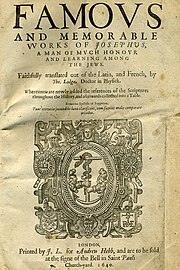
The extant manuscripts of the book Antiquities of the Jews, written by the first-century Jewish historian Flavius Josephus around AD 93–94, contain two references to Jesus of Nazareth and one reference to John the Baptist.
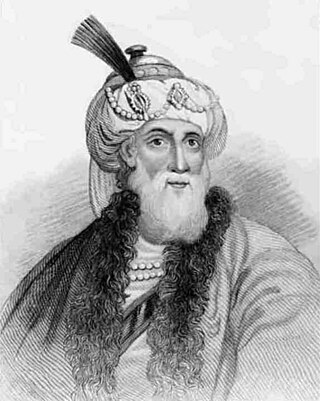
Flavius Josephus was a Roman–Jewish historian and military leader. Best known for writing The Jewish War, he was born in Jerusalem—then part of the Roman province of Judea—to a father of priestly descent and a mother who claimed royal ancestry.

The Roman historian and senator Tacitus referred to Jesus, his execution by Pontius Pilate, and the existence of early Christians in Rome in his final work, Annals, book 15, chapter 44.

James the Just, or a variation of James, brother of the Lord, was "a brother of Jesus", according to the New Testament. He was an early leader of the Jerusalem Church of the Apostolic Age. Traditionally, it is believed he was martyred in AD 62 or 69 by being stoned to death by the Pharisees on order of High Priest Ananus ben Ananus.
The historicity of Jesus is the question of whether or not Jesus of Nazareth historically existed. The mainstream scholarly consensus is that a Jewish man called Jesus of Nazareth did exist in Palestine in the 1st century CE. The contrary perspective, that Jesus was mythical, is regarded as a fringe theory.
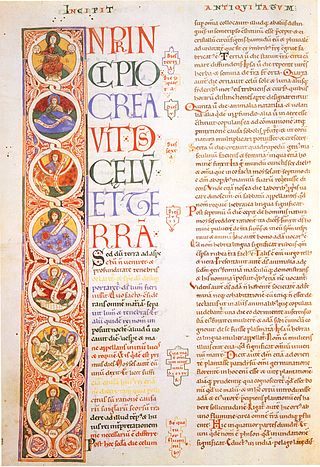
Antiquities of the Jews is a 20-volume historiographical work, written in Greek, by historian Josephus in the 13th year of the reign of Roman emperor Domitian, which was 94 CE. The book contains an account of the history of the Jewish people for Josephus' gentile patrons. In the first ten volumes, Josephus follows the events of the Hebrew Bible beginning with the creation of Adam and Eve.

The Jewish War or Judean War, also referred to in English as The Wars of the Jews, is a book written by Josephus, a first-century Roman-Jewish historian. It has been described by Steve Mason as "perhaps the most influential non-biblical text of Western history".
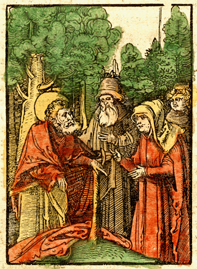
Matthew 3:5 is the fifth verse of the third chapter of the Gospel of Matthew in the New Testament. The verse occurs in the section introducing John the Baptist with this verse describing his popularity in the region.
Justus of Tiberias was a 1st century Jewish author and historiographer. All that we know of his life comes from the Vita which Flavius Josephus apparently wrote in response to the assertions made by Justus in his History of the Jewish War, published around 93/94 or shortly after 100. Josephus is moreover the only writer to mention this document, but without ever citing the slightest extract. This History published by Justus seems to have disappeared shortly after the publication of the Autobiography of Flavius Josephus, because it is unknown to pagan authors and the Christian authors who mention it only quote what Josephus said.
Shlomo Pines was an Israeli scholar of Jewish and Islamic philosophy, best known for his English translation of Maimonides' Guide of the Perplexed.
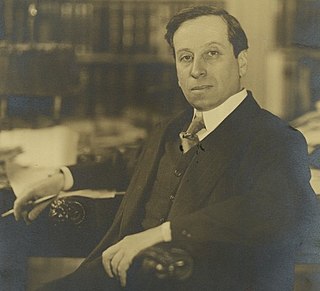
Robert Eisler was an Austrian Jewish polymath who wrote about the topics of mythology, comparative religion, the Gospels, monetary policy, art history, history of science, psychoanalysis, politics, astrology, history of currency, and value theory. He lectured at the Sorbonne and Oxford, served briefly on the International Committee on Intellectual Cooperation in Paris after World War I, and spent fifteen months imprisoned in Dachau and Buchenwald, where he developed heart disease. He is best remembered today for advancing a new picture of the historical Jesus based on his interpretation of the Slavonic Josephus manuscript tradition, proposing a dual currency system to control inflation, and arguing for a prehistoric derivation of human violence in Man into Wolf: An Anthropological Interpretation of Sadism, Masochism, and Lycanthropy. His life and work intersected with those of Sigmund Freud, Carl Jung, Alois Riegl, Gilbert Murray, Karl Popper, Hugo von Hofmannsthal, G. R. S. Mead, Aby Warburg, Fritz Saxl, Gershom Scholem, Oskar Goldberg, Martin Buber, and Walter Benjamin.
There is no scholarly consensus as to when the Hebrew Bible canon was fixed. Some scholars argue that it was fixed by the Hasmonean dynasty, while others argue it was not fixed until the second century CE or even later.
Ananus ben Ananus was a Herodian-era High Priest of Israel in Jerusalem, Judea Province. He was the High Priest who ordered the execution by stoning of James, the brother of Jesus, according to the Antiquities of the Jews of Josephus. A delegation sent by citizens upset over the perceived breach of justice met Lucceius Albinus before he reached Judea, and Albinus responded with a letter informing Ananus that it was illegal to convene the Sanhedrin without Albinus' permission and threatening to punish the priest. Ananus was therefore deposed by King Herod Agrippa II before Albinus's arrival and replaced with Jesus ben Damneus.

Louis Harry Feldman was an American professor of classics and literature. He was the Abraham Wouk Family Professor of Classics and Literature at Yeshiva University, the institution at which he taught since 1955.

Jesus son of Damneus was a Herodian-era High Priest of Judaea in Jerusalem, Iudaea Province.
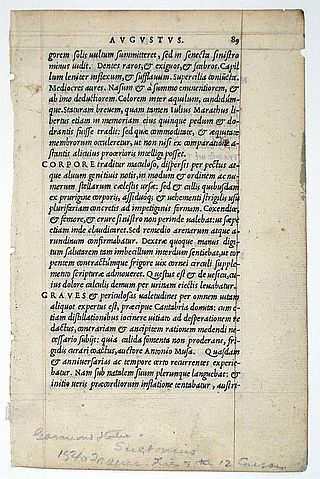
The Roman historian Suetonius mentions early Christians and may refer to Jesus Christ in his work Lives of the Twelve Caesars. One passage in the biography of the Emperor Claudius Divus Claudius 25, refers to agitations in the Roman Jewish community and the expulsion of Jews from Rome by Claudius during his reign, which may be the expulsion mentioned in the Acts of the Apostles. In this context "Chresto" is mentioned. Some scholars see this as a likely reference to Jesus, while others see it as referring to another person living in Rome, of whom we have no information.

Christian sources, such as the New Testament books in the Christian Bible, include detailed accounts about Jesus, but scholars differ on the historicity of specific episodes described in the biblical accounts of Jesus. The only two events subject to "almost universal assent" are that Jesus was baptized by John the Baptist and was crucified by the order of the Roman Prefect Pontius Pilate.
In textual criticism, Christian interpolation generally refers to textual insertion and textual damage to Jewish and pagan source texts during Christian scribal transmission.
Caesar's Messiah is a 2005 book by Joseph Atwill that argues that the New Testament Gospels were written by a group of individuals connected to the Flavian family of Roman emperors: Vespasian, Titus and Domitian. The authors were mainly Flavius Josephus, Berenice, and Tiberius Julius Alexander, with contributions from Pliny the Elder. Although Vespasian and Titus had defeated Jewish nationalist Zealots in the First Jewish–Roman War of 70 AD, the emperors wanted to control the spread of Judaism and moderate its political virulence and continuing militancy against Rome. Christianity, a pacifist and pro-Roman authority religion, was their solution.
The Josephines were Christian heretics condemned by Pope Lucius III's decree Ad abolendam in 1184 with the support of the Emperor Frederick I. They were "subject to a perpetual anathema" along with the Cathars and Patarenes, Humiliati, Poor Men of Lyon, Passagians and Arnaldists.
